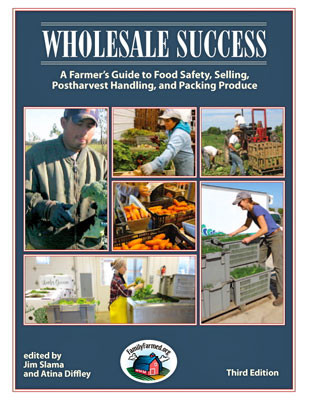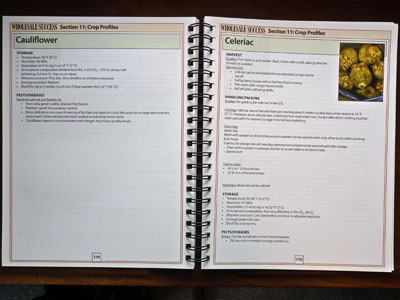 |
| Wholesale Success is a guide to wholesale marketing, including building relationships, crop planning and pricing, negotiating contracts, postharvest handling, cooling, packing and more. |
By Cheryl Wixson
The market demand for local and organic food is growing. In 1990, U.S. organic food sales were $1 billion; by 2011, they had grown to $31 billion. Certified-organic cropland has grown by 15 percent, and organic has been the fastest growing sector in the food industry since 1990.
According to the USDA, local food sales are also growing quickly, and demand for local food has become a hot trend in the food industry. Value-added food processors are increasing their purchases, institutional buyers such as schools, universities and hospitals want more local foods, and distributors are seeking more locally grown produce.
This increase in market demand represents a tremendous opportunity for farmers who have the capacity to scale up their operations and enter into the wholesale market. However, for many produce growers who primarily direct market through CSAs, farmers’ markets and farm stands, these wholesale markets present an entirely different set of opportunities and obstacles.
Producers may find that the stability and high-volume sales of wholesale markets increase the economic viability of their farm. Some may choose to diversify their sales by keeping the most profitable or convenient direct market sales and adding wholesale accounts once the farm reaches a certain size.
A book recently added to the MOFGA library, Wholesale Success: A Farmer’s Guide to Food Safety, Selling, Postharvest Handling, and Packing Produce, Third Edition, edited by Jim Slama and Atina Diffley and published by FamilyFarmed.org, provides an excellent roadmap for producers interested in developing wholesale markets.
The Guide walks the producer through the considerations in entering wholesale markets, including building relationships, crop planning and pricing, negotiating contracts or grower agreements and calculating return on investment. It also helps farmers build the skills that are keys to success in the market, including postharvest handling, cooling, packing, the buyer-seller relation, USDA grade standards and food safety. The goal of the Guide is to help farmers manage new, profitable business relationships, increase product quality, maximize shelf life and successfully manage wholesale sales.
 |
| Inside Wholesale Success |
The manual is sensibly organized into sections on preharvest preparation, harvesting, cooling and curing, cleaning and drying, sorting and packing, storage and transportation, and packing shed design. The section on food safety covers the basics of developing a farm food safety plan, and of farm and operation considerations, including agricultural water, animals and pest control, soil amendments and manure, and packing house design and activities. Although GAP (Good Agricultural Practices) is the book’s model farm food safety plan while MOFGA recommends a HACCP-based plan (Hazard Analysis and Critical Control Points), the information presented is relevant and important.
The Guide’s profiles of more than 100 crops, from apples to winter squash, are comprehensive, with detailed postharvest information, general harvest tips, quality descriptions, packaging standards, storage conditions, and the most common postharvest pests and diseases.
The Guide has numerous references, endnotes and links to USDA resources.
Cheryl Wixson, P.E., in 2013 was MOFGA’s agricultural engineer and food safety specialist.
